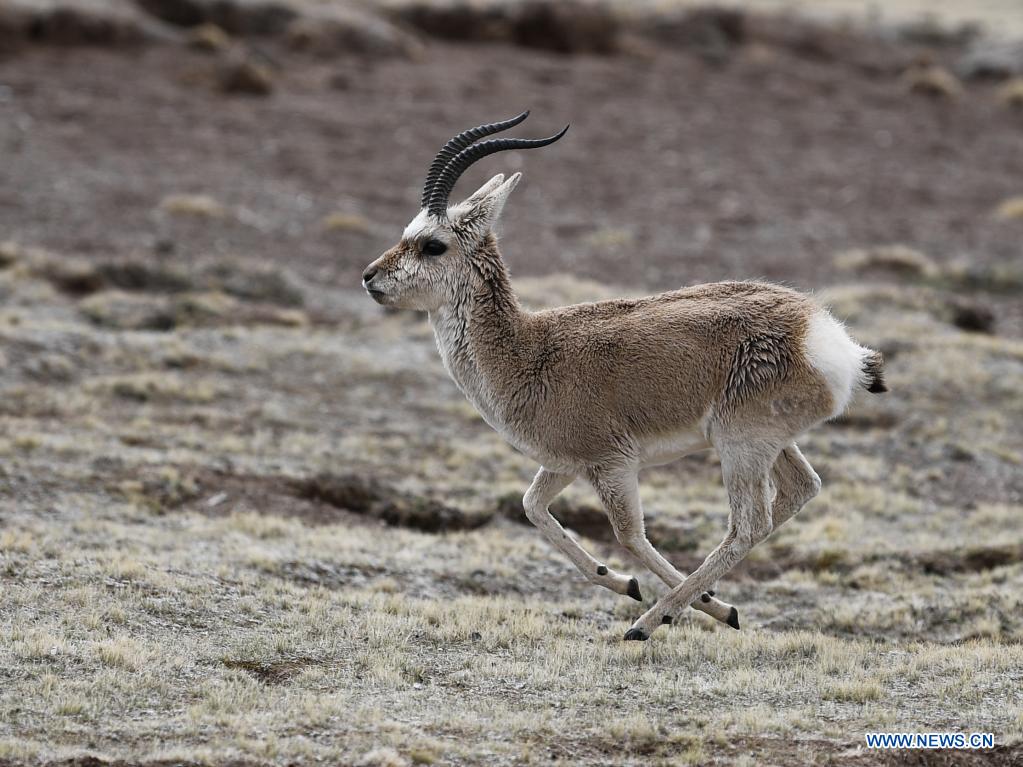China establishes a protected areas system with national parks as its mainstay
China has nearly 10,000 natural protected areas that includes national parks, nature reserves and natural parks, accounting for 18 percent of the country’s total land territory. Of the protected areas, 474 are under state-level protection.

A Tibetan antelope is seen at the source of the Yellow River section of the Sanjiangyuan National Park in Golog Tibetan Autonomous Prefecture of northwest China's Qinghai Province, May 25, 2021. (Xinhua/Zhang Long)
Under the framework of the National Forestry and Grassland Administration (National Park Administration) established in 2018, various localities across the country have rolled out efforts to push for the classified management of protected natural areas.
China categorizes protected natural areas into three types -- national parks, nature reserves and natural parks, based on the ecological value of the respective areas and the level of protection effort.
Last June, the country issued a guideline on the conservation of key ecosystems along with major restoration projects, taking various natural resources as the overall target for restoration efforts, including mountains, forests, grasslands, water resources, sand and ice ecosystems, while initiating plans to carry out 47 key restoration tasks.
National parks represent the most important parts of China’s natural systems. The Sanjiangyuan National Park in northwest China’s Qinghai Province, inaugurated in December 2015, is the country’s first national park. At present, the country has 10 pilot national parks that stretch across 12 provinces, with a total area exceeding 220,000 square km. The pilot national parks have been continually exploring effective protection methods since they started operations.
In the past, overlapping jurisdictions and a shortage of funds generated major difficulties for many protected natural areas. The only effective approach to solve these problems was to enhance top-level design and reform the protection systems, said He Wancheng, a former director of the administration bureau of the Sanjiangyuan National Park. The bureau, established in 2016, and with 18 separate protection stations, has basically resolved the challenges associated with overlapping jurisdictions and duties.
Over the past several years since the implementation of the national park program, the country has earmarked 6.26 billion yuan to fund national park restoration projects, patrolling and monitoring activities and fire prevention and control in forests and grasslands. The country’s financial ministry also allocated funds to aid forest, grassland, and wetland restoration projects.
As a result of these efforts, the populations of wild animals inhabiting these protected natural areas have been increasing. Statistics indicate that the well-planned protected areas system has brought 90 percent of terrestrial ecosystem types and 71 percent of key state-protected wildlife species under effective protection.
At the Sanjiangyuan National Park, the populations of Tibetan antelopes, Tibetan gazelles, and Tibetan wild donkeys have reached 70,000, 60,000 and 36,000, respectively. At the national park in northeast China home to the endangered Amur tiger, also called the Siberian tiger, along with the Amur Leopard (panthera pardus orientalis), 10 Siberian tiger cubs and seven Amur Leopard cubs were spotted in 2020.
The recovering populations of these endangered species reflects how effective the pilot national parks have been after implementing unified management and systemic restoration efforts. At the national park in south China’s Hainan province, the local forestry and grassland bureau, together with research institutes, installed more than 300 infrared cameras to monitor the activities of Hainan gibbons, one of the world’s rarest primates, on a real-time basis.
By engaging in environmental protection, local residents have likewise benefited from the institution of an ecological compensation mechanism. By taking advantage of its rich forestry resources, Mount Dabieshan National Park in central China’s Henan province has developed more than 10 tourism products, with the industry creating jobs for more than 6,000 people and lifting 1,500 impoverished people out of poverty. A park area situated inside the Sanjiangyuan National Park has launched experiential activities and environmental protection-related business activities, with 60 to 70 percent of monthly earnings being returned back to the cooperatives, farmers and herders involved in the delivery of such activities.
Photos
Related Stories
- Int'l forum to be held in October in Hong Kong on greener global shipping ecology
- Ecological project turns desert into oasis in Xinjiang's Makit
- Commentary: China's overseas coal power plant promise a paradigm shift
- China's ecological red lines provide wisdom for global environmental conservation
- National parks can effectively alleviate isolation of wild giant panda population: research
- Chinese scientists plant corals to restore seabed ecology
Copyright © 2021 People's Daily Online. All Rights Reserved.










